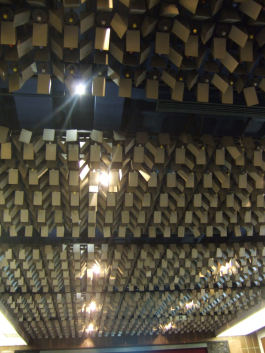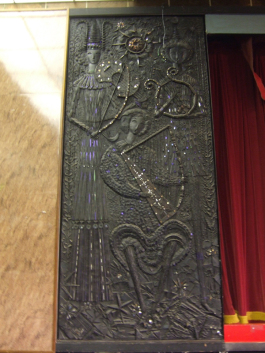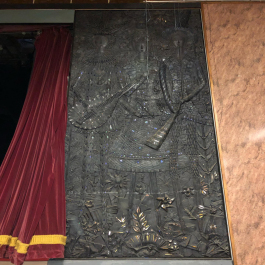
It’s 1974 and a new radio station is broadcasting from Manchester. Piccadilly Radio takes its name from its location, transmitting soul and disco from the mid-1960s modernist complex Piccadilly Plaza, which rises above Piccadilly Gardens, an angular piece of modernism in a city centre still largely characterised by dark Victorian warehouses and early twentieth century shops.
Four miles away in New Moston, a young Maureen Ward (later a co-founder of Manchester Modernist Society, then on the cusp of her teens), tunes in on her transistor radio. She immediately feels Piccadilly Radio is something new, for her and the young of the city. What’s more, she hears, there’s a place where she can go to hear its DJs: an all-ages disco in New Century Hall, located inside New Century House, a gleaming, 14-storey 1960s high-rise that’s visible from her flat in a tower block in what she sees as the dead, empty wilderness of north Manchester.
“New Century Hall and Piccadilly Plaza felt like they came from Mars”, she remembers. “Everything else was derelict or demolished, a decaying millscape of grand but dirty mills and warehouses, but they felt shiny and new. This brand new Manchester was enabling and bringing new ideas and harnessing youth culture: you could see yourself reflected in it. The discos at New Century Hall were cheap, accessible and young”.
This spirit of modernity and difference from what had gone before was in keeping with the spirit in which New Century Hall was conceived. Completed shortly after the adjacent CIS tower (the tallest building in Manchester when it opened in 1962 – and for decades afterwards), New Century House was designed by Gordon Tait with in-house architect GS Hay and built in 1962-63 as the new administrative headquarters of the Co-operative Wholesale Society (CWS) – an organisation which loomed large in the north Manchester of Ward’s childhood, both through branches of local co-operative societies and as a major local employer.
The CWS was founded in Manchester in 1863, building on the achievements of the Rochdale Equitable Pioneers’ Society, which was established by ordinary people in 1844 as an ethical and affordable way of providing groceries. As the CWS and its national and international networks of trade, manufacture and distribution grew, it developed a campus of buildings in the area surrounding Victoria station in Manchester, in an array of architectural styles. Central to early co-operative societies was a commitment to both education and to member participation and democracy. This was reflected in their buildings, which often incorporated facilities such as large meeting halls.

By the 1960s, the CWS was about to cross the threshold into its second century (hence the name) and realised the importance of moving with the times and looking ahead: co-operative societies had already pioneered new trends in retail, such as self-service supermarkets. As CWS President Leonard Cooke said, when formally opening New Century Hall on 18 May 1963: “The New Century Hall is more than a building, it is a declaration of faith in our future”.
The society revelled in the modernity of the building, which housed almost 400 staff. In June 1963, the employee magazine, Ourselves, dedicated five pages to the new premises. An article entitled “On top of the world” boasted that “everything is ultra-modern in new headquarters”. It highlighted the air conditioning that “gives a complete change of air every half hour”, as well as the light and airy offices with panoramic views and high-speed passenger lifts which could go from ground to top floor in 15 seconds.
The fit-out of New Century Hall was itself an exercise in co-operation, featuring the input of the CWS’ technical and service departments and electrical and engineering services. Its shopfitting department provided panelling and the CWS’s furniture divisions at Pelaw, Bristol and Radcliffe supplied chairs.
Cooke explained that, in its function as a meeting room, “great decisions will be taken here, affecting the progress and the policies of the co-operative movement and the CWS in particular”. Yet he also hoped that New Century Hall would become a “centre of culture for the people of Manchester, with plays, concerts, films and social gatherings of all description”.
Much was made in contemporary accounts of the hall’s technical specifications, including a modern projection room for film screenings as well as a stage and dressing room for theatrical productions. A promotional brochure described it as the “most up-to-date hall in the country”, detailing its fully sprung “Vultor” floor finished with “Muhuhu wood strips”, its unique ceiling, which combined metal sheet prisms with granulated cork with acoustic qualities, its tungsten lamps and fluorescent tube lights, its sound amplifiers, and a pair of glittering reliefs by the artist Steven Sykes depicting stylised musicians on either side of the stage.
The brochure suggested a list of functions, such as staff dances, cocktail parties, trade shows, orchestral concerts, film shows and meetings. New Century Hall soon became one of Manchester’s premier music venues, hosting acts that were far less staid and sedate than the CWS may have anticipated, including the Jimi Hendrix Experience and Jerry Lee Lewis among many other local and international acts.
Although she was too young for its 1960s musical heyday, by the mid-1970s New Century Hall was still part of a “constellation of modernity” for a young Maureen Ward, a place where she could “join the dots” with other emerging architectural and cultural developments. Piccadilly Plaza was a place for record shopping and picking up fliers. The Arndale centre, opened in stages between 1972 and 1979, became a place teens in their school uniforms could visit to experience new and unknown fashions (before buying flares and wedges at the underground market across the road). New Century Hall, still only just over a decade old, stood out as “big, bare, clean and bright – not dingy, but glamorous”. These buildings were, like the music Ward was listening to, new, exciting and a definite break with the townscape and culture of her parents’ generation.

Originally published in The Modernist, Issue Nº 48 (Music), October 2023

It’s 1974 and a new radio station is broadcasting from Manchester. Piccadilly Radio takes its name from its location, transmitting soul and disco from the mid-1960s modernist complex Piccadilly Plaza, which rises above Piccadilly Gardens, an angular piece of modernism in a city centre still largely characterised by dark Victorian warehouses and early twentieth century shops.
Four miles away in New Moston, a young Maureen Ward (later a co-founder of Manchester Modernist Society, then on the cusp of her teens), tunes in on her transistor radio. She immediately feels Piccadilly Radio is something new, for her and the young of the city. What’s more, she hears, there’s a place where she can go to hear its DJs: an all-ages disco in New Century Hall, located inside New Century House, a gleaming, 14-storey 1960s high-rise that’s visible from her flat in a tower block in what she sees as the dead, empty wilderness of north Manchester.
“New Century Hall and Piccadilly Plaza felt like they came from Mars”, she remembers. “Everything else was derelict or demolished, a decaying millscape of grand but dirty mills and warehouses, but they felt shiny and new. This brand new Manchester was enabling and bringing new ideas and harnessing youth culture: you could see yourself reflected in it. The discos at New Century Hall were cheap, accessible and young”.
This spirit of modernity and difference from what had gone before was in keeping with the spirit in which New Century Hall was conceived. Completed shortly after the adjacent CIS tower (the tallest building in Manchester when it opened in 1962 – and for decades afterwards), New Century House was designed by Gordon Tait with in-house architect GS Hay and built in 1962-63 as the new administrative headquarters of the Co-operative Wholesale Society (CWS) – an organisation which loomed large in the north Manchester of Ward’s childhood, both through branches of local co-operative societies and as a major local employer.
The CWS was founded in Manchester in 1863, building on the achievements of the Rochdale Equitable Pioneers’ Society, which was established by ordinary people in 1844 as an ethical and affordable way of providing groceries. As the CWS and its national and international networks of trade, manufacture and distribution grew, it developed a campus of buildings in the area surrounding Victoria station in Manchester, in an array of architectural styles. Central to early co-operative societies was a commitment to both education and to member participation and democracy. This was reflected in their buildings, which often incorporated facilities such as large meeting halls.

By the 1960s, the CWS was about to cross the threshold into its second century (hence the name) and realised the importance of moving with the times and looking ahead: co-operative societies had already pioneered new trends in retail, such as self-service supermarkets. As CWS President Leonard Cooke said, when formally opening New Century Hall on 18 May 1963: “The New Century Hall is more than a building, it is a declaration of faith in our future”.
The society revelled in the modernity of the building, which housed almost 400 staff. In June 1963, the employee magazine, Ourselves, dedicated five pages to the new premises. An article entitled “On top of the world” boasted that “everything is ultra-modern in new headquarters”. It highlighted the air conditioning that “gives a complete change of air every half hour”, as well as the light and airy offices with panoramic views and high-speed passenger lifts which could go from ground to top floor in 15 seconds.
The fit-out of New Century Hall was itself an exercise in co-operation, featuring the input of the CWS’ technical and service departments and electrical and engineering services. Its shopfitting department provided panelling and the CWS’s furniture divisions at Pelaw, Bristol and Radcliffe supplied chairs.
Cooke explained that, in its function as a meeting room, “great decisions will be taken here, affecting the progress and the policies of the co-operative movement and the CWS in particular”. Yet he also hoped that New Century Hall would become a “centre of culture for the people of Manchester, with plays, concerts, films and social gatherings of all description”.
Much was made in contemporary accounts of the hall’s technical specifications, including a modern projection room for film screenings as well as a stage and dressing room for theatrical productions. A promotional brochure described it as the “most up-to-date hall in the country”, detailing its fully sprung “Vultor” floor finished with “Muhuhu wood strips”, its unique ceiling, which combined metal sheet prisms with granulated cork with acoustic qualities, its tungsten lamps and fluorescent tube lights, its sound amplifiers, and a pair of glittering reliefs by the artist Steven Sykes depicting stylised musicians on either side of the stage.
The brochure suggested a list of functions, such as staff dances, cocktail parties, trade shows, orchestral concerts, film shows and meetings. New Century Hall soon became one of Manchester’s premier music venues, hosting acts that were far less staid and sedate than the CWS may have anticipated, including the Jimi Hendrix Experience and Jerry Lee Lewis among many other local and international acts.
Although she was too young for its 1960s musical heyday, by the mid-1970s New Century Hall was still part of a “constellation of modernity” for a young Maureen Ward, a place where she could “join the dots” with other emerging architectural and cultural developments. Piccadilly Plaza was a place for record shopping and picking up fliers. The Arndale centre, opened in stages between 1972 and 1979, became a place teens in their school uniforms could visit to experience new and unknown fashions (before buying flares and wedges at the underground market across the road). New Century Hall, still only just over a decade old, stood out as “big, bare, clean and bright – not dingy, but glamorous”. These buildings were, like the music Ward was listening to, new, exciting and a definite break with the townscape and culture of her parents’ generation.

Originally published in The Modernist, Issue Nº 48 (Music), October 2023